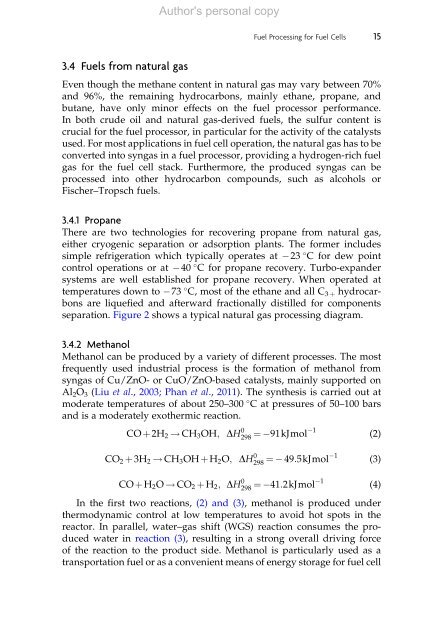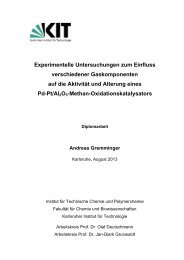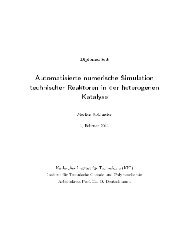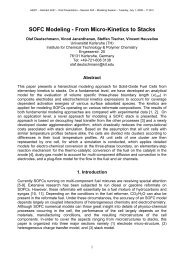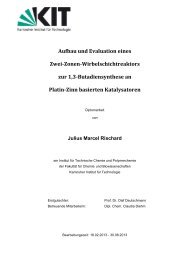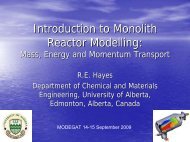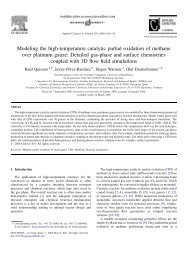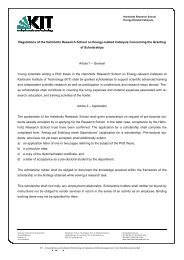Fuel Processing for Fuel Cells - Institut für Technische Chemie und ...
Fuel Processing for Fuel Cells - Institut für Technische Chemie und ...
Fuel Processing for Fuel Cells - Institut für Technische Chemie und ...
You also want an ePaper? Increase the reach of your titles
YUMPU automatically turns print PDFs into web optimized ePapers that Google loves.
Author's personal copy<br />
<strong>Fuel</strong> <strong>Processing</strong> <strong>for</strong> <strong>Fuel</strong> <strong>Cells</strong> 15<br />
3.4 <strong>Fuel</strong>s from natural gas<br />
Even though the methane content in natural gas may vary between 70%<br />
and 96%, the remaining hydrocarbons, mainly ethane, propane, and<br />
butane, have only minor effects on the fuel processor per<strong>for</strong>mance.<br />
In both crude oil and natural gas-derived fuels, the sulfur content is<br />
crucial <strong>for</strong> the fuel processor, in particular <strong>for</strong> the activity of the catalysts<br />
used. For most applications in fuel cell operation, the natural gas has to be<br />
converted into syngas in a fuel processor, providing a hydrogen-rich fuel<br />
gas <strong>for</strong> the fuel cell stack. Furthermore, the produced syngas can be<br />
processed into other hydrocarbon compo<strong>und</strong>s, such as alcohols or<br />
Fischer–Tropsch fuels.<br />
3.4.1 Propane<br />
There are two technologies <strong>for</strong> recovering propane from natural gas,<br />
either cryogenic separation or adsorption plants. The <strong>for</strong>mer includes<br />
simple refrigeration which typically operates at 23 C <strong>for</strong> dew point<br />
control operations or at 40 C <strong>for</strong> propane recovery. Turbo-expander<br />
systems are well established <strong>for</strong> propane recovery. When operated at<br />
temperatures down to 73 C, most of the ethane and all C 3 þ hydrocarbons<br />
are liquefied and afterward fractionally distilled <strong>for</strong> components<br />
separation. Figure 2 shows a typical natural gas processing diagram.<br />
3.4.2 Methanol<br />
Methanol can be produced by a variety of different processes. The most<br />
frequently used industrial process is the <strong>for</strong>mation of methanol from<br />
syngas of Cu/ZnO- or CuO/ZnO-based catalysts, mainly supported on<br />
Al 2 O 3 (Liu et al., 2003; Phan et al., 2011). The synthesis is carried out at<br />
moderate temperatures of about 250–300 C at pressures of 50–100 bars<br />
and is a moderately exothermic reaction.<br />
CO þ 2H 2 ! CH 3 OH; DH 0 298 ¼ 91kJmol 1 (2)<br />
CO 2 þ 3H 2 ! CH 3 OH þ H 2 O; DH 0 298 ¼ 49:5kJmol 1 (3)<br />
CO þ H 2 O ! CO 2 þ H 2 ; DH 0 298 ¼ 41:2kJmol 1 (4)<br />
In the first two reactions, (2) and (3), methanol is produced <strong>und</strong>er<br />
thermodynamic control at low temperatures to avoid hot spots in the<br />
reactor. In parallel, water–gas shift (WGS) reaction consumes the produced<br />
water in reaction (3), resulting in a strong overall driving <strong>for</strong>ce<br />
of the reaction to the product side. Methanol is particularly used as a<br />
transportation fuel or as a convenient means of energy storage <strong>for</strong> fuel cell


